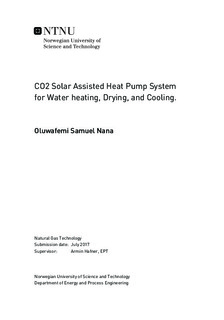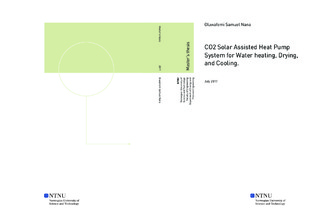| dc.description.abstract | Solar energy is often considered as waste energy in the world as only few percentage of the solar energy reaching the earth being harnessed for use. With growing demand in heating and cooling demands around the world, it has become imperative that research be focused on how to make use of this waste energy. Heat pumps are considered better in meeting cooling and heating loads, a CO2 as choice refrigerant. Not only those CO2 have better thermodynamic properties, it is environmentally friendly as it does not contribute to ozone layer depletion with a global warming potential of 1.
With this study, theoretical analysis of integrated CO2 heat pump has been carried out and experimental campaign has been able to justify the potentials of integrating a solar collector to a CO2 heat pump with multiple loads (cooling and heating). A region with relative high solar radiation was selected and with the aid of a simulation tool, RHVAC, the corresponding cooling load required for residential purpose was determined. This cooling load served as reference load for the air evaporator. Improvising the solar collector with a glycol evaporator, additional heat was absorbed into the system, thereby increasing the heating capacity of the heat pump. The cooling load reference for the air evaporator ranges from 2.37 to 2.73 kW. A single transcritical heat pump was simulated in Pack calculation to predict the behavior of the system with only the air evaporator. Depending on the amount of heat supplied from glycol, an heat increase of twice the it s initial capacity was recorded.
The system parameters were varied to predict their influence on system performance. At 2.37 kW cooling load, the highest COP of 3.97 and 3.67 for heating and cooling at an evaporation temperature of 10℃ with a high side pressure of 84 bar. At a cooling load of 2.73 kW, the highest obtainable COP for heating and Cooling were 4.04 and 3.55 respectively at an evaporation temperature of 10℃ and high side pressure of 90 bar. The seasonal energy efficiency ratio (SEER) rating of the air evaporator was also performed. The performance of the system for drying applications was also carried out with a potential drying efficiency of 66% calculated. It was further discovered that integrating the dryer with the air evaporator at 2.73 kW cooling capacity, the drying efficiency increased to about 75%.
The performance of CO2 heat pump was compared to alternative refrigerants, R134a and R410a. The CO2 system had a better cooling performance than both refrigerants. | |

